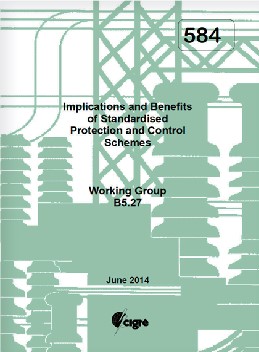CIGRE Technical Brochure 584 – Working Group B5.27

Reviewed by Alexander Apostolov, USA
The electric power Industry is going through a transition from the traditional grid of the last century towards the Smart Grid of the twenty first century. The main characteristics of the Smart Grid are improvements in the reliability, security and efficiency of its operation. In order to help the industry, achieve these goals, CIGRE established working group B5.27 “Implications and Benefits of Standardized Protection and Control Schemes.”
The task of the working group was to identify what is standardized design philosophy and what are the current levels of standardization in utilities, consultants and manufacturers. It also had to investigate what are the main drivers for utilities, manufacturers and contractors to apply standardized solutions as well as what are the barriers for doing it.
Convener of the working group was Dr. Alexander Apostolov, IEEE Fellow and Distinguished member of CIGRE from the USA, with more than thirty-five years of experience with consultants, utilities and manufacturers. The working group included twelve Regular members – all experienced experts from European countries, plus five Corresponding members from Asia, Africa and Australia. The combined experience and expertise of the members of the working group was the main factor leading to the publication of a technical brochure that can be used by PAC specialists from around the world as a guide in the definition and implementation of their standardization process.
The brochure starts with an Introduction, followed by Definitions of different terms used in the document.
Chapter 3 concentrates on the drivers and benefits of the standardization of protection and control schemes. Time and cost savings, together with improvements in quality and risk reduction are identified.
Chapter 4 defines the methodology for a standardization process with four stages:
- Standard Scheme – Template (Development Stage “A”)
- Standard Scheme – Defined (Development Stage “B”)
- Standard Scheme – Applied (Development Stage “C”)
- Standard Scheme – Instantiated (Development Stage “D”)
This stage model and standard components are later discussed. The subject of standardization and standard formats are described, followed by discussions on feedback, troubleshooting and refinement of the process of development and implementation of standard protection and control scheme, as well as their version control. The design approval process and the requirements for training are discussed and illustrated with application examples.
The following four chapters of the brochure are concentrated on the detailed description of the implementation of each of the four standard scheme development stages listed above.
Chapter 9 is concentrated on contractual and organizational issues. It considers the need for in-house expertise and the main contractual models. Issues such as the number of contractors, the terms of contracts and the transition between contractors are discussed in detail. Another topic is the responsibilities of the involved parties and the implications for the utilities’ internal organization.
Chapter 10 is focused on the barriers for standardization and the risks that it may impose. Application expertise during the standardization process, a wide variety of legacy designs and primary equipment practices and layouts are some of the barriers that are covered. The impact of the human factor is also discussed. Application volumes, loss of expertise and the impact of type failures are considered as risks for standardization.
Chapter 11 is the analysis of the survey. It starts with an introduction to the survey and the types of questions included in it, followed by a summary and analysis of the answers.
The last section of the chapter includes the conclusions that the members of the working group have drawn from the survey results.
The brochure ends with six appendices providing actual implementation examples from utilities and a manufacturer, as well as the results from the survey conducted by the working group.
This brochure is a valuable tool for any specialist that is working on the development of standardized protection, automation and control schemes.
Implications and Benefits of Standardised Protection and Control Schemes
CIGRE Technical Brochure 584
ISBN: 978-2-85873-280-7








